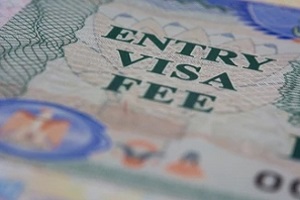TheK-3 visa allows a U.S. citizen’s spouse to enter the country with temporary legal status while they await permanent residency (a “green card”). However, the K-3 visa may be unneeded if better options are available. Find out more in this brief article.
Eligibility For K-3 Visas
The K-3 visa is for spouses who were legally married outside of the United States and meet the following requirements:
- The petitioner must be the legal spouse of a citizen of the United States. (Spouses of U.S. green card holders are not eligible for the K-3 visa.)
- The applicant must be a citizen of a nation other than the United States.
- The U.S. citizen spouse must have previously submitted a family sponsorship application (Form I-130) to USCIS, which is now pending. This Form I-130 must not yet have been granted, and in the meantime, a receipt letter from USCIS must be present.
- The spouse who is a U.S. citizen must meet specific income standards. To qualify as a financial sponsor, their adjusted gross income on their most recent tax return must be at least 100% of the Federal Poverty Guidelines. A dual sponsor must file an “affidavit of support” if they are not capable of achieving this criterion.
- If the applicant has biological or adopted children who would also come to the United States (on a K-4 visa), the children must be under the age of 21 and unmarried.
Form I-129F
If all of the aforementioned requirements are completed, the U.S. citizen spouse must complete and submit Form I-129F to USCIS. This form’s name is a little misleading because it is called “Petition for Alien Fiancé(e),” but it can also be used by spouses of U.S. citizens.
Copies of all relevant documents should be added to the form once it has been finished and signed, including:
- The passport, naturalization certificate, or birth certificate of the U.S. citizen spouse as proof of citizenship.
- The passport of the applicant’s spouse.
- Certified English translation of a legal marriage certificate.
- Proof of the end of any previous marriages (annulment document, divorce decree or death certificate).
- If the applicant spouse has ever obtained an I-94 arrival/departure record from US Customs and Border Protection (CBP).
- One passport-style photograph of the applicant spouse and one passport-style photograph of the U.S. citizen spouse.
- Notice of Receipt for Form I-130 (technically called Form I-797).
Unlike the I-129F petition for fiancé(e), the I-129F petition for spouses does not require a filing fee.
It’s always a good idea to make an archival copy of the packet after signing Form I-129F and to attach all of the supporting documents before submitting it.
The U.S. citizen spouse should get a receipt notice approximately 30 days after Form I-129F is filed. This signifies that USCIS has received the package and is processing it. The length of time it takes to process a case depends on which USCIS service center is processing it, but it usually takes approximately 10–13 months. Should USCIS require any additional information during this time, a Request for Evidence (RFE) may be issued. The U.S. citizen spouse will obtain an approval notice once the petition is authorized.
DS-160 Form And Interview
 The applicant spouse will receive contact from the U.S. Embassy in their native country around 30 days after USCIS accepts Form I-129F. The date and time of the applicant spouse’s interview at the U.S. embassy or consulate in their native country will be included in this email. It will also provide a list of documents that must be brought to the interview.
The applicant spouse will receive contact from the U.S. Embassy in their native country around 30 days after USCIS accepts Form I-129F. The date and time of the applicant spouse’s interview at the U.S. embassy or consulate in their native country will be included in this email. It will also provide a list of documents that must be brought to the interview.
The next step is to submit the DS-160 visa application online to the Department of State, which requires uploading a passport-style photo. After submitting the DS-160 electronically, print the confirmation page and bring it to the interview with the relevant documentation:
- Certificate of legal marriage.
- For the application spouse, a valid, unexpired passport is required.
- Certificate of birth for the applicant’s spouse.
- For the applicant spouse, police clearance was received from all countries of residency for more than six months since the age of sixteen.
- For the applicant spouse, a confidential medical examination is required (obtained from a physician abroad as authorized by the Department of State).
- Affidavit of support from the sponsor (Form I-134).
- Latest tax returns of the sponsoring spouse.
- Relationship proof (a copy of the pending Form I-130 package originally filed with USCIS, for example). It’s also a good idea to include items like wedding photographs or other confirmation of the marriage’s validity.
- Two passport-style photos of the applicant’s spouse are required.
 The current visa filing fee from the State Department is $265, which is normally paid at the time of the interview. It’s crucial to read the embassy’s correspondence for exact instructions on payment time and location, which may differ based on the applicant’s home country.
The current visa filing fee from the State Department is $265, which is normally paid at the time of the interview. It’s crucial to read the embassy’s correspondence for exact instructions on payment time and location, which may differ based on the applicant’s home country.
The interview is normally set 4–6 weeks after the embassy mail is received. The applicant should be notified of the decision the same day or soon after. If additional evidence is required, the consular officer will request that it be sent to the U.S. consulate. The spouse can go to the United States once the K-3 visa is approved.
Processing Time For K3 Visas
K-3 visa processing takes 3–13 months on average. This is roughly how long USCIS takes to approve a marriage green card application. Most people decide that applying for a K-3 visa is not worth it because of the lengthy processing time. The K-3 visa should usually be avoided unless processing times improve, as it entails an unnecessary step and significant expenditure (including a $265 filing fee). In 2019, the USCIS only issued five K-3 visas, demonstrating how uncommon it is for couples to pick this option.
Obtaining A Green Card
The final stage in this procedure is to fly to the U.S. on a K-3 visa that has been approved. While K-3 visa holders can apply for work permission when they arrive in the U.S., they are not allowed to work until their work permit application is approved, which takes about four months.
As a result, it may be preferable to file for employment permission and a travel permit at the same time as the green card application. It can then be submitted once in the United States. Depending on a pending or approved Form I-130, this application, Form I-485 (officially called an “Adjustment of Status” application), is filed with USCIS.
Work With An Immigration Attorney To Secure K-3 Visa Status
The K-3 visa is accessible to spouses of U.S. citizens residing overseas — however, it is usually not a good option and should be avoided. Because of the long response time, filing for a K-3 visa often becomes a waste of time and money (including the additional $265 filing fee).
If a couple is already married and has a Form I-130 pending, they are almost always better off pursuing a green card through “consular processing,” which takes about the same time as the K-3 visa process.
When the applicant’s spouse arrives in the U.S. with an issued green card, they will be allowed to work right away as a permanent resident without having to file any further paperwork. Click here for more information about marriage-based green cards.
It’s also worth noting that K-3 visas (a Nonimmigrant Visa for a Spouse) aren’t available in Canada. As a result, the only two U.S. immigration possibilities for couples with one partner of Canadian nationality are the K-1 Fiancé(e) visa (for unmarried couples) or the CR-1/IR-1 Spousal visa (for couples who are already married).
If you have any questions or concerns regarding the K-3 Visa process, please don’t hesitate to reach out to our helpful and professional staff at Pride Immigration for further details and information.
Beeraj Patel, Esq.
Latest posts by Beeraj Patel, Esq. (see all)
- Transitioning to Permanent Residency Through Adjustment of Status for Asylum Seekers - April 14, 2025
- What to Do If Your Employer Withdraws Support During the Green Card Process - March 31, 2025
- How a Green Card Attorney Can Help with Complex Immigration Cases Involving Family Separation - March 17, 2025

